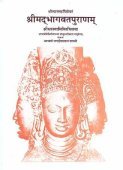Samkhyayoga, Sāṅkhyayoga, Sāṃkhyayoga, Sankhyayoga, Sankhya-yoga: 8 definitions
Introduction:
Samkhyayoga means something in Hinduism, Sanskrit. If you want to know the exact meaning, history, etymology or English translation of this term then check out the descriptions on this page. Add your comment or reference to a book if you want to contribute to this summary article.
In Hinduism
Vaishnavism (Vaishava dharma)
Source: ISKCON Press: GlossarySāṅkhyayoga (साङ्ख्ययोग).—The process of linking with the Supreme by intellectually tracing out the source of creation.
Source: Pure Bhakti: Bhagavad-gita (4th edition)Sāṅkhyayoga (साङ्ख्ययोग) refers to “Yoga that gives analytical knowledge about scientific knowledge of the soul, the Supersoul and inert objects”. (cf. Glossary page from Śrīmad-Bhagavad-Gītā).

Vaishnava (वैष्णव, vaiṣṇava) or vaishnavism (vaiṣṇavism) represents a tradition of Hinduism worshipping Vishnu as the supreme Lord. Similar to the Shaktism and Shaivism traditions, Vaishnavism also developed as an individual movement, famous for its exposition of the dashavatara (‘ten avatars of Vishnu’).
Purana and Itihasa (epic history)
Source: archive.org: Shiva Purana - English TranslationSāṃkhyayoga (सांख्ययोग) refers to the “doctrines of Sāṃkhya and Yoga”, according to the Śivapurāṇa 2.5.16 (“The battle of the gods”).—Accordingly, as Brahmā and the Gods eulogized Viṣṇu: “[...] Obeisance to you of the form of Kalki; the destroyer of outcastes, Obeisance to him of infinite power and who establishes good virtue. Obeisance to you of the form of Kapila of great soul and who expounded the doctrines of Sāṃkhya and Yoga (sāṃkhyayoga) to Devahūtī; O lord, obeisance to you the preceptor of Sāṃkhya. Obeisance to great yogin and saint who expounds the great wisdom. Obeisance to the creator of the form of knowledge whereby the soul is delighted. [...]”.
Source: Cologne Digital Sanskrit Dictionaries: The Purana IndexSāṅkhyayoga (साङ्ख्ययोग).—Revealed by Viṣṇu: taught by Kapila to Āsuri.1 Here tattvas or first principles are taught. Puruṣa the eternal, acts as agent to get things done by the guṇas of Prakṛti. Its relation to Bhaktiyoga.2 Its principles are differently enumerated as eleven, five, three and so on; according to one's yuktī or reason. Creation of universe according to Sānkhya, and the place of Prakṛti and Puruṣa therein.3 Followed by Kṛṣṇa while ruling from Dvārakā and by Nārada in his worship of Naranārāyaṇa.4 Practised by Vairājasas;5 is itself a kind of yoga;6 born out of the creator.7
- 1) Bhāgavata-purāṇa I. 3. 10; II. 1. 6; V. 18. 33; Matsya-purāṇa 3. 29; Vāyu-purāṇa 30. 293.
- 2) Bhāgavata-purāṇa III. 24. 17; 25. 31; ch. 26 (whole); 29 2; Vāyu-purāṇa 61. 111.
- 3) Bhāgavata-purāṇa XI. 22. 1-25; Bhā 24 (whole).
- 4) ch. III. 3. 19; V. 19. 10; IX. 8. 14; X. 8. 45; XI. 14. 20.
- 5) Matsya-purāṇa 13. 5.
- 6) Ib. 52. 3; 110; 19; 182. 18; 183. 44; Vāyu-purāṇa 66. 110.
- 7) Matsya-purāṇa 183. 50; 184. 24; 245. 87; 247. 9; 248. 17; 291. 2.

The Purana (पुराण, purāṇas) refers to Sanskrit literature preserving ancient India’s vast cultural history, including historical legends, religious ceremonies, various arts and sciences. The eighteen mahapuranas total over 400,000 shlokas (metrical couplets) and date to at least several centuries BCE.
Languages of India and abroad
Sanskrit dictionary
Source: Cologne Digital Sanskrit Dictionaries: Cappeller Sanskrit-English DictionarySāṃkhyayoga (सांख्ययोग).—[masculine] an adherent of the Sāmkhya and Yoga systems; [neuter] the [Simple] and Y.
Source: Cologne Digital Sanskrit Dictionaries: Monier-Williams Sanskrit-English Dictionary1) Saṃkhyāyoga (संख्यायोग):—[=saṃ-khyā-yoga] m. a [particular] constellation (relating to the number of Nakṣatras in which a planet is situated), [Varāha-mihira’s Bṛhat-saṃhitā]
2) Sāṃkhyayoga (सांख्ययोग):—[=sāṃkhya-yoga] [from sāṃkhya] m. ‘adherent of the S° and Yoga’, Name of a Ṛṣi, [Mahābhārata xiii, 7123] ([varia lectio] -yogau)
3) [v.s. ...] ‘application of the S° doctrine to the knowledge of spirit’, Name of the 2nd [chapter] of the Bhagavad-gītā
4) [v.s. ...] the so-called theistical S°, [Śaṃkarācārya]
5) [v.s. ...] n. the S° and the Y°, [Mahābhārata]
[Sanskrit to German]
Sanskrit, also spelled संस्कृतम् (saṃskṛtam), is an ancient language of India commonly seen as the grandmother of the Indo-European language family (even English!). Closely allied with Prakrit and Pali, Sanskrit is more exhaustive in both grammar and terms and has the most extensive collection of literature in the world, greatly surpassing its sister-languages Greek and Latin.
Kannada-English dictionary
Source: Alar: Kannada-English corpusSāṃkhyayōga (ಸಾಂಖ್ಯಯೋಗ):—[noun] = ಸಾಂಖ್ಯ [samkhya]2 - 4.
Kannada is a Dravidian language (as opposed to the Indo-European language family) mainly spoken in the southwestern region of India.
See also (Relevant definitions)
Partial matches: Samkhya, Yoga.
Starts with: Samkhyayogadipika, Samkhyayogapravartin, Samkhyayogavadin, Samkhyayogavant, Samkhyayogavat.
Full-text (+9): Astika, Samkhyayogadipika, Samkhyayogapravartin, Samkhyayogavat, Samkhyayogavadin, Anvikshiki, Upashloka, Shriharsha, Samkhya, Nabhasa, Anubhava, Shushkatarka, Satkaryavada, Aparasparasambhuta, Vallaki, Pravartin, Vacaspati-mishra, Ninda, Pratishedha, Parashreyas.
Relevant text
Search found 75 books and stories containing Samkhyayoga, Sāṅkhyayoga, Sāṅkhyayōga, Sāṃkhyayoga, Saṃkhyāyoga, Sāṃkhyayōga, Sāṅkhya-yoga, Sāṃkhya-yoga, Saṃkhyā-yoga, Samkhya-yoga, Sankhyayoga, Sankhya-yoga; (plurals include: Samkhyayogas, Sāṅkhyayogas, Sāṅkhyayōgas, Sāṃkhyayogas, Saṃkhyāyogas, Sāṃkhyayōgas, yogas, Sankhyayogas). You can also click to the full overview containing English textual excerpts. Below are direct links for the most relevant articles:
Yoga-sutras (with Vyasa and Vachaspati Mishra) (by Rama Prasada)
Sūtra 4.21 < [Book 4 - Absolute Independence (Kaivalya)]
Sūtra 1.25 < [Book 1 - Trance (Samādhi)]
Jnaneshwari (Bhavartha Dipika) (by Ramchandra Keshav Bhagwat)
Anumana in Indian Philosophy (by Sangita Chakravarty)
(C). Fallacies in Anumāna (in Sāṃkhya-Yoga Philosophy) < [Chapter 3 - Treatment of Anumāna in Sāṃkhya-Yoga Philosophy]
Shrimad Bhagavad-gita (by Narayana Gosvami)
Verse 2.39 < [Chapter 2 - Sāṅkhya-yoga (Yoga through distinguishing the Soul from the Body)]
Chapter 2 - Sāṅkhya-yoga (Yoga through distinguishing the Soul from the Body)
Verse 13.25 < [Chapter 13 - Prakṛti-puruṣa-vibhāga-yoga]
Philosophy of Charaka-samhita (by Asokan. G)
World Construction (Sāṃkhya and Caraka) < [Chapter 3 - Fundamental Theories]
Darśanas (philosophical speculations) < [Chapter 1 - Introduction]
Concept of liberation in other philosophical systems < [Chapter 8 - Ethics]
Narayaniya (Narayaneeyam) (by Vishwa Adluri)
Related products

